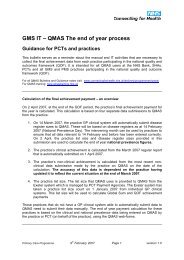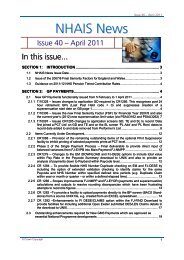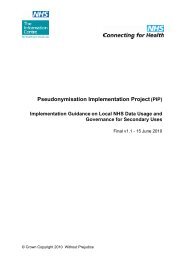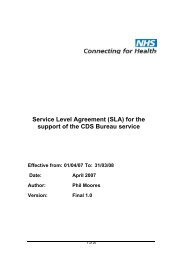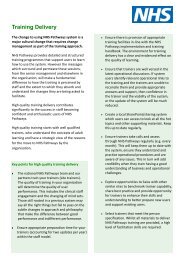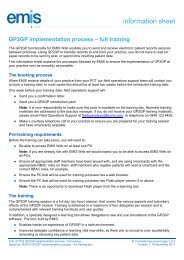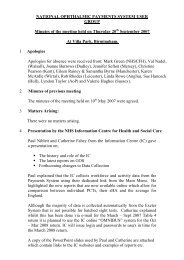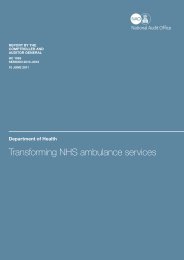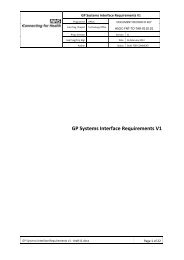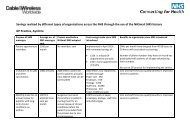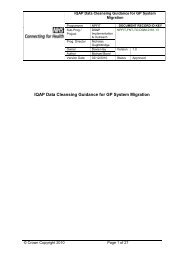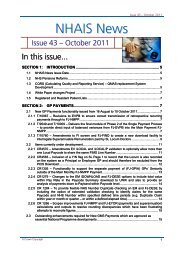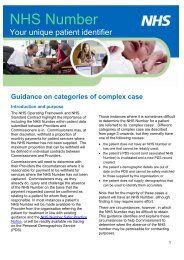NHS Number FAQs - Systems
NHS Number FAQs - Systems
NHS Number FAQs - Systems
Create successful ePaper yourself
Turn your PDF publications into a flip-book with our unique Google optimized e-Paper software.
This document aims to answer frequently asked questions from<br />
<strong>NHS</strong> staff about the <strong>NHS</strong> <strong>Number</strong>. If you have any feedback or<br />
need further information please contact the <strong>NHS</strong> <strong>Number</strong> team at<br />
nhsnumber@nhs.net or visit<br />
http://www.connectingforhealth.nhs.uk/systemsandservices/nhsnu<br />
mber/
Contents<br />
1 Using and Sharing the <strong>NHS</strong> <strong>Number</strong> ................................................................. 5<br />
1.1 Benefits of the <strong>NHS</strong> <strong>Number</strong> and the importance of using it .................................. 5<br />
1.1.1 General Practice .......................................................................................... 5<br />
1.1.2 Clinical care ................................................................................................. 5<br />
1.1.3 Hospital administration ................................................................................. 5<br />
1.1.4 Reception & administration staff .................................................................. 5<br />
1.2 Do we need the person's consent to store, use and share their <strong>NHS</strong> <strong>Number</strong> .... 6<br />
1.3 Can the <strong>NHS</strong> <strong>Number</strong> be used for occupational health records .......................... 6<br />
1.4 Who do I contact to get a <strong>NHS</strong> Provider <strong>Number</strong> ................................................ 6<br />
2 General Practice .................................................................................................. 7<br />
2.1 How are <strong>NHS</strong> <strong>Number</strong>s allocated in primary care i.e. to a patient who wishes to<br />
register with a new practice ................................................................................. 7<br />
2.2 Should GP Practices refuse to register patients who do not know their <strong>NHS</strong><br />
<strong>Number</strong> ............................................................................................................... 7<br />
2.3 Do GP Practices need to inform patients of their <strong>NHS</strong> <strong>Number</strong> to comply with the<br />
<strong>NHS</strong> <strong>Number</strong> Safer Practice Notice or <strong>NHS</strong> <strong>Number</strong> standards ......................... 7<br />
3 Newborns and the <strong>NHS</strong> <strong>Number</strong> ........................................................................ 8<br />
3.1 How can I allocate an <strong>NHS</strong> <strong>Number</strong> for a baby ................................................... 8<br />
3.2 I need an <strong>NHS</strong> <strong>Number</strong> for my system to operate and the baby does not have<br />
one yet. What do I do .......................................................................................... 8<br />
3.3 Does the PDS include foetal information ............................................................. 8<br />
3.4 Do <strong>NHS</strong> <strong>Number</strong>s have to be used when prescribing medicines in advance for a<br />
patient who is not born (for example HIV medicines to be given at birth). ........... 9<br />
4 <strong>NHS</strong> <strong>Number</strong> Communication .......................................................................... 10<br />
4.1 What communication material is available to support the <strong>NHS</strong> <strong>Number</strong> ............ 10<br />
4.2 Obtaining communication material ....................................................................... 10<br />
4.3 Communicating the <strong>NHS</strong> <strong>Number</strong> to a patient ..................................................... 10<br />
5 Standards Implementation ............................................................................... 11<br />
5.1 Current <strong>NHS</strong> <strong>Number</strong> standards and implementation .......................................... 11<br />
5.3 The <strong>NHS</strong> <strong>Number</strong> Implementation Guidance refers to patient-facing information.<br />
What does this mean ........................................................................................ 11<br />
5.4 How do the Information Governance (IG) Toolkit timelines fit with the<br />
implementation timelines for the <strong>NHS</strong> <strong>Number</strong> standards ................................. 11<br />
5.5 Do the <strong>NHS</strong> <strong>Number</strong> Standards just cover active patients ................................. 12<br />
5.6 Is there a standard format for the <strong>NHS</strong> <strong>Number</strong> ................................................ 12<br />
6 Finding <strong>NHS</strong> <strong>Number</strong>s (<strong>NHS</strong> <strong>Number</strong> tracing) ................................................ 13
6.1 What happens when a patient gives misleading demographics information, for<br />
example a drug addict who is seeking to receive treatment from multiple<br />
organisations ..................................................................................................... 13<br />
6.2 How can I populate my records with the <strong>NHS</strong> <strong>Number</strong> ...................................... 13<br />
6.3 I do not have a N3 connection or access to the Demographic Batch Service<br />
(DBS) in order to connect to the Personal Demographics Service (PDS) to obtain<br />
the patients details - how can I get <strong>NHS</strong> <strong>Number</strong>s ............................................ 14<br />
6.4 What is the Migration Analysis Clearing Services (MACS) ................................ 14<br />
6.5 In what circumstances will I be unable to find a patient on the Personal<br />
Demographic Service (PDS) ............................................................................. 14<br />
6.6 Does the <strong>NHS</strong> <strong>Number</strong> have to be recorded for people who wish to remain<br />
anonymous........................................................................................................ 20<br />
6.7 How can I get a list of <strong>NHS</strong> <strong>Number</strong>s for all our prison population .................... 21<br />
7 Data Quality ....................................................................................................... 21<br />
7.1 What is the Personal Demographics Service (PDS) National Back Office (NBO)<br />
............................................................................................................................ 21<br />
7.2 How do I resolve a demographic data quality issue ........................................... 21<br />
7.3 How do I deal with a patient with two <strong>NHS</strong> <strong>Number</strong>s ......................................... 22<br />
7.4 I work in an <strong>NHS</strong> organisation and need to update the records of some patients,<br />
including the <strong>NHS</strong> <strong>Number</strong>. How can I find this information .............................. 22<br />
8 Technical implementation of standard ............................................................ 23<br />
8.1 <strong>NHS</strong> <strong>Number</strong> vs. local identifiers ......................................................................... 23<br />
8.2 What <strong>NHS</strong> <strong>Number</strong> verification statuses are acceptable ................................... 23<br />
8.3 What percentage of verified <strong>NHS</strong> <strong>Number</strong>s do we need on our system ............ 24<br />
8.4 What is a Modulus 11 algorithm ......................................................................... 25<br />
8.5 How does a local organisation assess which systems are applicable and conform<br />
to the standard .................................................................................................. 26<br />
8.6 Are self check-in systems „applicable systems‟ ................................................. 27<br />
8.7 What is happening with Picture Archiving and Communication System (PACS)<br />
with regard to the <strong>NHS</strong> <strong>Number</strong> ........................................................................ 27<br />
9 Supplier Conformance ...................................................................................... 28<br />
9.1 Where can I find information about the progress system suppliers are making in<br />
complying with the Data Set Change Notice (DSCN) 31/2008 (GP standard) .. 28<br />
9.2 Where can I find information about the progress system suppliers are making in<br />
complying with the DSCN notice 32/2008 (secondary care standard) .............. 28<br />
10 Safer Practice Notice ........................................................................................ 29<br />
10.1 How should the Safer Practice Notice mandating the use of the <strong>NHS</strong> <strong>Number</strong> be<br />
implemented ...................................................................................................... 29<br />
10.2 Is there any safer practice information available about the printing and use of<br />
wristbands for newborns ................................................................................... 29
11 Cross-border use of the <strong>NHS</strong> <strong>Number</strong> ............................................................ 30<br />
11.1 How do I determine the <strong>NHS</strong> <strong>Number</strong> for a patient from another country within<br />
the United Kingdom, such as Wales ................................................................. 30<br />
11.2 How can we be sure that the range of numbers used for Scotland Central Health<br />
Index (CHI) which begin with patients‟ date of birth will remain discrete and not<br />
be repeated within the generated <strong>NHS</strong> <strong>Number</strong>s from the Personal Demographic<br />
Service (PDS) ................................................................................................... 31<br />
12 Adult social care and local authorities ............................................................ 32<br />
12.1 Can the <strong>NHS</strong> <strong>Number</strong> be used by social services ............................................. 32<br />
12.2 Can I have more information regarding the <strong>NHS</strong> <strong>Number</strong> and social care ........ 32<br />
12.3 Can we store a carer's <strong>NHS</strong> <strong>Number</strong> ................................................................ 32<br />
13 Future <strong>NHS</strong> <strong>Number</strong> standards ........................................................................ 33<br />
13.1 Do independent contractors need to use the <strong>NHS</strong> <strong>Number</strong> .............................. 33<br />
13.2 Which areas will be included within the scope of the community care standard33<br />
13.3 Dentistry .............................................................................................................. 33
1 Using and Sharing the <strong>NHS</strong> <strong>Number</strong><br />
1.1 Benefits of the <strong>NHS</strong> <strong>Number</strong> and the importance of using it<br />
The <strong>NHS</strong> <strong>Number</strong> is the only national unique patient identifier. Using the <strong>NHS</strong> <strong>Number</strong><br />
helps share patient information safely, efficiently and accurately. This helps reduce<br />
clinical risk to patients and improves financial flows.<br />
As the delivery of patient care is often shared across a number of health and social care<br />
organisations, the effective linking-up and flow of information related to a patient has<br />
become even more important, the <strong>NHS</strong> <strong>Number</strong> helps to link records across<br />
organisations.<br />
1.1.1 General Practice<br />
Using the <strong>NHS</strong> <strong>Number</strong> enables GP Practices to:<br />
Accurately link the patient to their record<br />
Transfer patient records electronically using GP2GP<br />
Make referrals using Choose and Book<br />
Send electronic prescription messages<br />
Accurately identify patients in all communications with secondary and community<br />
care teams.<br />
1.1.2 Clinical care<br />
The <strong>NHS</strong> <strong>Number</strong> is important to clinical care because it:<br />
Is the only national unique patient identifier<br />
Supports safer identification practices<br />
Helps create a complete record, linking every episode of care across<br />
organisations<br />
Supports health and social care integration.<br />
1.1.3 Hospital administration<br />
The <strong>NHS</strong> <strong>Number</strong> is important to hospital administration because:<br />
It helps create a complete record for each patient<br />
It enables information to be safely transferred across organisational boundaries<br />
Babies are given their own <strong>NHS</strong> <strong>Number</strong> at birth to link their healthcare records<br />
for life.<br />
1.1.4 Reception & administration staff<br />
To improve patient safety by ensuring the right records are connected to the right<br />
patient, reception and administration staff should:<br />
Ask a patient to provide their <strong>NHS</strong> <strong>Number</strong>; this should be printed on their<br />
appointment letter or card<br />
Check if each patient has a <strong>NHS</strong> <strong>Number</strong> on the local clinical system<br />
Ask each patient to confirm, name, address and date of birth including the correct<br />
spelling.<br />
Page 5 of 34
1.2 Do we need the person's consent to store, use and share their <strong>NHS</strong><br />
<strong>Number</strong><br />
The <strong>NHS</strong> <strong>Number</strong> is used to link a person to their health record. If the <strong>NHS</strong> <strong>Number</strong> is<br />
collected, stored and used for the purpose of caring for a person then consent is not<br />
required.<br />
In social care, the <strong>NHS</strong> <strong>Number</strong> is not as well established, but there are Department of<br />
Health policies and guidance documents, stating that the <strong>NHS</strong> <strong>Number</strong> may be used for<br />
joint health and social care purposes. In 2008, Department of Health policy guidance<br />
stated that the <strong>NHS</strong> <strong>Number</strong> may be used for social care records (see link below).<br />
http://www.dh.gov.uk/en/Publicationsandstatistics/Publications/PublicationsPolicyAndGu<br />
idance/DH_098444<br />
The <strong>NHS</strong> <strong>Number</strong> programme‟s scope does not include the definition of data sharing<br />
principles between organisations. Therefore, it is important that local organisations<br />
establish data sharing agreements between themselves and other organisations,<br />
particularly in the private and voluntary sectors.<br />
If you are unsure about data sharing and/or the use of the <strong>NHS</strong> <strong>Number</strong> you should in<br />
the first instance seek further advice from your Caldicott Guardian or local information<br />
governance team.<br />
1.3 Can the <strong>NHS</strong> <strong>Number</strong> be used for occupational health records<br />
The <strong>NHS</strong> <strong>Number</strong> can be used on occupational health records. In line with the Data<br />
Protection Act, all staff should be informed that this information is being collected and<br />
how it will be used.<br />
1.4 Who do I contact to get a <strong>NHS</strong> Provider <strong>Number</strong><br />
To obtain a <strong>NHS</strong> Provider <strong>Number</strong> you need to contact the <strong>NHS</strong>' Organisation Data<br />
Service.<br />
Their contact details are:<br />
Organisation Data Service (ODS)<br />
<strong>NHS</strong> Connecting for Health<br />
Hexagon House<br />
Pynes Hill<br />
Rydon Lane<br />
Exeter<br />
Devon EX2 5SE<br />
ODS helpdesk number: 01392 251289<br />
Email: exeter.helpdesk@nhs.net<br />
Page 6 of 34
2 General Practice<br />
2.1 How are <strong>NHS</strong> <strong>Number</strong>s allocated in primary care i.e. to a patient who<br />
wishes to register with a new practice<br />
As part of registration patients will need to complete a GMS1 form at the new practice.<br />
The patient should be encouraged to provide as much information as possible, including<br />
their <strong>NHS</strong> <strong>Number</strong> if known. If the patient does not know their <strong>NHS</strong> <strong>Number</strong>, it can be<br />
traced if there has been previous contact with the <strong>NHS</strong>.<br />
The practice will then pass the patient‟s information to the primary care registration back<br />
office, usually electronically, though their GP system. The patient‟s records will then be<br />
transferred to the new practice, either electronically using GP2GP, or by the paperbased<br />
transfer system.<br />
Patients who have never been in contact with the <strong>NHS</strong> or previously registered with a<br />
GP Practice will be allocated an <strong>NHS</strong> <strong>Number</strong> by the primary care registration back<br />
office. The local GP record will then be updated to include the <strong>NHS</strong> <strong>Number</strong> and the<br />
PCT should communicate the <strong>NHS</strong> <strong>Number</strong> to the patient i.e. through the issue of a<br />
medical card or welcome letter in line with their usual new patient registration process.<br />
General guidance for GP practices is available here:<br />
http://www.connectingforhealth.nhs.uk/systemsandservices/nhsnumber/staff/documents<br />
/gppracguide.pdf<br />
2.2 Should GP Practices refuse to register patients who do not know<br />
their <strong>NHS</strong> <strong>Number</strong><br />
No, GP Practices cannot refuse to register patients simply on the grounds that they do<br />
not know their <strong>NHS</strong> <strong>Number</strong>.<br />
2.3 Do GP Practices need to inform patients of their <strong>NHS</strong> <strong>Number</strong> to<br />
comply with the <strong>NHS</strong> <strong>Number</strong> Safer Practice Notice or <strong>NHS</strong> <strong>Number</strong><br />
standards<br />
GP Practices are asked to ensure that patients are aware of their <strong>NHS</strong> <strong>Number</strong>. The<br />
requirement can be met by the PCT sending out <strong>NHS</strong> <strong>Number</strong>s to patients i.e. by<br />
issuing a medical card. Patients who ask for their <strong>NHS</strong> <strong>Number</strong> should be provided with<br />
it once they are correctly identified.<br />
Page 7 of 34
3 Newborns and the <strong>NHS</strong> <strong>Number</strong><br />
3.1 How can I allocate an <strong>NHS</strong> <strong>Number</strong> for a baby<br />
All babies born in hospitals in England have an application for an <strong>NHS</strong> <strong>Number</strong> made<br />
electronically by the midwife in charge of the birth. The midwife saves the babies<br />
information and applies for the <strong>NHS</strong> <strong>Number</strong> via NN4B (using either Maternity<br />
Information system: the Interim <strong>NHS</strong> <strong>Number</strong> Service (INNS) or local PAS application to<br />
N3 and Spine) to the <strong>NHS</strong> <strong>Number</strong> Central Issuing Service (CIS). As long as all the<br />
information is correct, an <strong>NHS</strong> <strong>Number</strong> will be emailed straight back (usually within<br />
seconds). Parents do not have to „do‟ anything for an <strong>NHS</strong> <strong>Number</strong> to be allocated in<br />
this way.<br />
Anyone born in England, Wales or the Isle of Man since October 2002 will have an <strong>NHS</strong><br />
<strong>Number</strong>. Babies <strong>NHS</strong> <strong>Number</strong>s are allocated by a system called <strong>NHS</strong> <strong>Number</strong>s for<br />
Babies (NN4B). The allocation is totally random and <strong>NHS</strong> <strong>Number</strong>s previously used will<br />
never be reused. The maternity unit will inform the mother of their baby‟s <strong>NHS</strong> <strong>Number</strong><br />
directly, usually by printing out a label with the baby‟s details and <strong>NHS</strong> <strong>Number</strong>. This<br />
label may be attached:<br />
To a leaflet called „<strong>NHS</strong> <strong>Number</strong> - From Birth for Life‟<br />
To a letter / form<br />
Inside the baby‟s „Red Book‟<br />
Reasons an <strong>NHS</strong> <strong>Number</strong> cannot be automatically allocated may include:<br />
Inaccurate or incomplete information entered by the midwife<br />
A technical problem at the hospital IT services<br />
The details submitted closely match another baby born at the same time<br />
elsewhere in the country.<br />
If a baby does not have an <strong>NHS</strong> <strong>Number</strong> allocated automatically in this way, the child<br />
health services in an area are responsible for applying for the <strong>NHS</strong> <strong>Number</strong>. If parents<br />
are unsure about a baby‟s <strong>NHS</strong> <strong>Number</strong> they can ask their health visitor or GP.<br />
3.2 I need an <strong>NHS</strong> <strong>Number</strong> for my system to operate and the baby does<br />
not have one yet. What do I do<br />
If the baby is a newborn, contact the midwife/system manager for <strong>NHS</strong> <strong>Number</strong> for<br />
Babies (NN4B) at the maternity unit where the baby was born.<br />
If it is more than 48 hours after a baby‟s birth, contact the relevant child health<br />
department, who can see if a number has been allocated or allocate one if none is<br />
found.<br />
3.3 Does the PDS include foetal information<br />
The Personal Demographics Service (PDS) does not include separate foetal information<br />
or have a separate record for the foetus. DH guidance is as follows:<br />
From 24 weeks pregnancy all foetuses, whether or not they survive, require an<br />
<strong>NHS</strong> <strong>Number</strong><br />
Page 8 of 34
Therefore:<br />
A baby born showing any signs of life after birth – regardless of gestation period<br />
– is a Registerable Birth and will have an <strong>NHS</strong> <strong>Number</strong> allocated.<br />
a) Guidance and systems do not cater for allocation of an <strong>NHS</strong> <strong>Number</strong> to a foetus<br />
in the event of, for example, obtaining samples from that foetus<br />
b) A still-born, under 24 weeks - will not be allocated an <strong>NHS</strong> <strong>Number</strong><br />
c) A still-born over 24 weeks - will be allocated an <strong>NHS</strong> <strong>Number</strong><br />
d) Foetuses over 24 weeks - will get an <strong>NHS</strong> <strong>Number</strong> at birth.<br />
3.4 Do <strong>NHS</strong> <strong>Number</strong>s have to be used when prescribing medicines in<br />
advance for a patient who is not born (for example HIV medicines to<br />
be given at birth).<br />
An unborn foetus cannot be registered as a patient and as a result will not have a <strong>NHS</strong><br />
<strong>Number</strong>. Therefore when treating an unborn foetus an <strong>NHS</strong> <strong>Number</strong> is not necessary.<br />
Page 9 of 34
4 <strong>NHS</strong> <strong>Number</strong> Communication<br />
4.1 What communication material is available to support the <strong>NHS</strong><br />
<strong>Number</strong><br />
An <strong>NHS</strong> <strong>Number</strong> communications toolkit has been developed to support awarenessraising<br />
activity and support implementation of the <strong>NHS</strong> <strong>Number</strong> Standards and Safer<br />
Practice Notice.<br />
The toolkit contains:<br />
An information leaflet for patients<br />
A <strong>NHS</strong> <strong>Number</strong> for Babies information leaflet for patients<br />
An information leaflet for staff<br />
A poster for patients<br />
A poster for staff<br />
Case studies of <strong>NHS</strong> <strong>Number</strong> awareness-raising projects undertaken in some<br />
areas, and the supporting materials they used.<br />
The toolkit can be accessed at:<br />
www.connectingforhealth.nhs.uk/nhsnumber/toolkit<br />
4.2 Obtaining communication material<br />
All <strong>NHS</strong> <strong>Number</strong> communication materials are available in the <strong>NHS</strong> <strong>Number</strong><br />
communications toolkit. The toolkit includes web and print versions of the national <strong>NHS</strong><br />
<strong>Number</strong> communications materials. The web versions are downloadable and the print<br />
versions can be used to print locally. These can be accessed at:<br />
www.connectingforhealth.nhs.uk/nhsnumber/toolkit<br />
Some of the <strong>NHS</strong> <strong>Number</strong> material is also available in printed format. You can see a list<br />
and place an order via the <strong>NHS</strong> Connecting for Health „resources‟ webpage.<br />
http://information.connectingforhealth.nhs.uk/default.aspxCategory=<strong>NHS</strong>%20<strong>Number</strong><br />
%20Awareness<br />
4.3 Communicating the <strong>NHS</strong> <strong>Number</strong> to a patient<br />
It is helpful for <strong>NHS</strong> staff to obtain the patient‟s <strong>NHS</strong> <strong>Number</strong> as early as possible. This<br />
helps staff to find and share their patients‟ medical records more safely and easily.<br />
Ensuring patients know their <strong>NHS</strong> <strong>Number</strong>s helps them to be identified correctly and<br />
their records found efficiently wherever they receive care.<br />
Patients should be able to find their <strong>NHS</strong> <strong>Number</strong> on their medical card or letter<br />
provided when they registered with their GP, or recent correspondence from the <strong>NHS</strong><br />
(e.g. prescription, appointment letter). Alternatively they can contact their local PCT and<br />
ask for the department dealing with <strong>NHS</strong> <strong>Number</strong> enquiries. Registration staff will take<br />
their name, date of birth and address and then send them their <strong>NHS</strong> <strong>Number</strong>. Staff may<br />
ask patients for written confirmation of their identity. Alternatively, the GP or practice<br />
staff treating the patient would be able to advise the patient of their <strong>NHS</strong> <strong>Number</strong>.<br />
More information can be found at www.connectingforhealth.nhs.uk/nhsnumber<br />
Page 10 of 34
For more information please see the MOD <strong>FAQs</strong> at<br />
http://nww.connectingforhealth.nhs.uk/demographics/modfaqs<br />
5 Standards Implementation<br />
5.1 Current <strong>NHS</strong> <strong>Number</strong> standards and implementation<br />
The <strong>NHS</strong> <strong>Number</strong> full Operational Information Standards for General Practice and<br />
Secondary Care were published by the Information Standards Board (ISB) in December<br />
2008.<br />
http://www.isb.nhs.uk/docs/instantations/nhs-number<br />
An Implementation Guidance document has been developed to support the adoption of<br />
these standards. You can download the fully-designed version of the <strong>NHS</strong> <strong>Number</strong><br />
Implementation Guidance (PDF, 9Mb).<br />
Please note that this document is nine megabytes and, depending on your internet<br />
connection speed, may take some time download. The separate sections are listed<br />
below for your convenience. You can download the full plain text version (PDF, 422Kb).<br />
6.2 Do you have any guidance / documentation on how to implement the <strong>NHS</strong><br />
<strong>Number</strong>, e.g. business cases, project plans and project initiation<br />
documents<br />
Please contact your local SHA <strong>NHS</strong> <strong>Number</strong> lead for information relating to the<br />
implementation of <strong>NHS</strong> <strong>Number</strong>. Local contact details are available on the <strong>NHS</strong> <strong>Number</strong><br />
website:<br />
http://www.connectingforhealth.nhs.uk/systemsandservices/nhsnumber/staff/sha-leads<br />
5.3 The <strong>NHS</strong> <strong>Number</strong> Implementation Guidance refers to patient-facing<br />
information. What does this mean<br />
The term „patient-facing information‟ refers to documents/letters/outputs from electronic<br />
patient record systems that are meant for patients. These communications must bear<br />
the <strong>NHS</strong> <strong>Number</strong> as the key identifier for that patient, along with consistent<br />
demographic details (e.g. names and address).<br />
Patient-facing information can also mean any generic information (i.e. not patient<br />
specific) that has been produced for patients, for example an information leaflet<br />
explaining what an <strong>NHS</strong> <strong>Number</strong> is and why it is important.<br />
5.4 How do the Information Governance (IG) Toolkit timelines fit with the<br />
implementation timelines for the <strong>NHS</strong> <strong>Number</strong> standards<br />
The IG Toolkit version 8, requirement 401, level 2, says that trusts should be in the<br />
process of implementing the <strong>NHS</strong> <strong>Number</strong> standard by March 2010. All trusts should<br />
complete the Standard by December 2010. For further queries on the IG Toolkit please<br />
contact exeter.helpdesk@nhs.net<br />
Page 11 of 34
5.5 Do the <strong>NHS</strong> <strong>Number</strong> Standards just cover active patients<br />
The <strong>NHS</strong> <strong>Number</strong> Standards are for active patients. <strong>NHS</strong> <strong>Number</strong> Standards would<br />
need to be followed for a patient defined locally as „active‟. At present <strong>NHS</strong><br />
organisations must ensure that a minimum of 95 per cent of all active patient records<br />
have a <strong>NHS</strong> <strong>Number</strong>. Processes should be put in place to escalate and resolve records<br />
locally where a <strong>NHS</strong> <strong>Number</strong> cannot be found.<br />
5.6 Is there a standard format for the <strong>NHS</strong> <strong>Number</strong><br />
The <strong>NHS</strong> <strong>Number</strong> must be displayed and printed in a „3 3 4‟ format (e.g. 123 456 7890).<br />
<strong>Systems</strong> must also allow the <strong>NHS</strong> <strong>Number</strong> to be input into the appropriate data field on<br />
screen as 10 digits with or without spaces. This is documented fully in the <strong>NHS</strong> <strong>Number</strong><br />
Information Standards.<br />
http://www.isb.nhs.uk/docs/instantations/nhs-number<br />
Page 12 of 34
6 Finding <strong>NHS</strong> <strong>Number</strong>s (<strong>NHS</strong> <strong>Number</strong> tracing)<br />
6.1 What happens when a patient gives misleading demographics<br />
information, for example a drug addict who is seeking to receive<br />
treatment from multiple organisations<br />
As a matter of Department of Health policy, the <strong>NHS</strong> does not require a patient to verify<br />
their identity in order to receive <strong>NHS</strong> care. Although patients have the right to withhold<br />
their true identity, they should be made aware that if they do not give consistent<br />
information their continuity of care may be compromised. If their record cannot be<br />
traced then an <strong>NHS</strong> <strong>Number</strong> should be allocated.<br />
Where a patient gives incorrect information and fraud is suspected, this should be<br />
reported to Counter Fraud and Security Management Services. You can find more<br />
information at:<br />
<strong>NHS</strong> Counter Fraud Services http://www.nhsbsa.nhs.uk/fraud<br />
<strong>NHS</strong> Security Management Services http://www.nhsbsa.nhs.uk/security<br />
6.2 How can I populate my records with the <strong>NHS</strong> <strong>Number</strong><br />
Finding an <strong>NHS</strong> <strong>Number</strong> for a person is achieved by searching for their record on the<br />
Personal Demographics Service (PDS), the national demographics database, and<br />
obtaining their <strong>NHS</strong> <strong>Number</strong>. This process is referred to as „tracing‟.<br />
Tracing can be completed by one of 3 methods:<br />
Multiple records batched in a file through the Demographics Batch Service (DBS)<br />
One record at a time through the demographics tracing functionality within<br />
Summary Care Record Application (SCRa)<br />
Local IT systems with an online interface to the PDS service<br />
All of these methods require an N3 connection, i.e. a connection to the <strong>NHS</strong> secure<br />
network. You can find more information at:<br />
http://www.connectingforhealth.nhs.uk/systemsandservices/n3<br />
Please note that in order to use the demographics tracing within SCRa your staff will<br />
need Smartcards, so you will need to contact your registration authority.<br />
Further information can be found on the following <strong>NHS</strong> Connecting for Health web<br />
pages:<br />
Personal Demographics Service and tracing<br />
http://www.connectingforhealth.nhs.uk/systemsandservices/demographics<br />
Summary Care Record application<br />
http://www.connectingforhealth.nhs.uk/systemsandservices/scr/staff/impguidpm/s<br />
cra<br />
Smartcards and Registration Authorities<br />
(http://www.connectingforhealth.nhs.uk/systemsandservices/rasmartcards)<br />
Page 13 of 34
If you have a N3 connection and you would like to use the Demographic Batch Service<br />
(DBS) you can approach the Demographics team at demographics@nhs.net to find out<br />
more details.<br />
6.3 I do not have a N3 connection or access to the Demographic Batch<br />
Service (DBS) in order to connect to the Personal Demographics<br />
Service (PDS) to obtain the patients details - how can I get <strong>NHS</strong><br />
<strong>Number</strong>s<br />
If you do not have a N3 connection you could approach your PCT so see if they can<br />
perform a trace on your behalf through their own N3 connection or by matching against<br />
their local database. This should be considered as a one-off solution to populate your<br />
current set of records, as it will be unlikely that the PCT will be able to do this on a<br />
regular basis. Following this, DBS and the demographics tracing functionality within<br />
SCRa can be used but it will depend on the number and frequency of new records on<br />
your system.<br />
6.4 What is the Migration Analysis Clearing Services (MACS)<br />
MACS can be used for hard–to-trace patient <strong>NHS</strong> <strong>Number</strong>s, where sufficient history<br />
does not appear on the demographic tracing functionality within SCRa or DBS.<br />
Further information can be found at:<br />
http://www.connectingforhealth.nhs.uk/systemsandservices/data/dataquality/macs<br />
6.5 In what circumstances will I be unable to find a patient on the<br />
Personal Demographic Service (PDS)<br />
A small proportion of patients treated by the <strong>NHS</strong> will not have a record on PDS and<br />
<strong>NHS</strong> <strong>Number</strong>; this is less than 3% of all patients.<br />
Guidance has been produced for <strong>NHS</strong> Trusts allocating <strong>NHS</strong> <strong>Number</strong>s to patients, to<br />
help avoid the duplication of patient records on the Personal Demographics Service.<br />
This guidance applies to any organisation either currently „allocating <strong>NHS</strong> <strong>Number</strong>s‟ to<br />
patients or in the process of implementing this capability. It is available from:<br />
http://nww.connectingforhealth.nhs.uk/demographics/allocatenumber.pdf<br />
Page 14 of 34
There are a number of circumstances when it may be difficult to find a patient on the<br />
PDS:<br />
Category<br />
Adoption Cases<br />
Description<br />
Currently individuals who go through the adoption process<br />
will have their new details including a new <strong>NHS</strong> <strong>Number</strong><br />
added onto Personal Demographics Service (PDS).<br />
Department for Education Ministers have reconfirmed their<br />
agreement to retain the original <strong>NHS</strong> number of adopted<br />
children, and use the Personal Demographics Service (PDS)<br />
„Sensitive' ('S‟) flag to shield the location of children placed for<br />
adoption (where the Local Authority (LA) believes this is<br />
necessary to protect the child). The assumption from <strong>NHS</strong><br />
Connecting for Health is that there will be a relatively small<br />
number of cases where the S-flag is appropriate. The new<br />
process will help to ensure continuity of health records for an<br />
adopted child.<br />
It has yet to be fully agreed how the new arrangement will<br />
work in practice, and the date the new arrangement will be<br />
implemented is therefore not yet known. Planning has begun<br />
under the leadership of DfE officials and with the involvement<br />
of representatives of the various stakeholders.<br />
Post implementation, there will no longer be a requirement for<br />
the PDS National Back Office (NBO) to invalidate original<br />
PDS records and create new PDS records for all adopted<br />
children. Instead, the adopted child's new name will be<br />
recorded as a change of name on the child's original PDS<br />
record, and when the child registers with a new General<br />
Practitioner (GP), the child's medical history will be<br />
transferred accordingly. There will be additional steps built<br />
into the process to shield the child's location, where it is<br />
considered necessary by the LA.<br />
The PDS NBO has proposed immediate changes to the way<br />
that in-family cases are handled, where the name has already<br />
been changed on health records prior to adoption. We are<br />
awaiting confirmation from DfE that this is acceptable,<br />
pending final agreement on implementation of the process as<br />
a whole.<br />
Page 15 of 34
Category<br />
Armed Forces<br />
Personnel and<br />
Service<br />
Dependents<br />
(MOD)<br />
Description<br />
The Ministry of Defence (MOD) is currently engaged, through<br />
a partnership agreement with the Department of Health (DH),<br />
in a cross government programme to enable access to a<br />
number of national <strong>NHS</strong> services and applications for military<br />
personnel and any civilian patients registered with Defence<br />
Medical Services (DMS). For more information please see the<br />
MOD <strong>FAQs</strong> at<br />
http://nww.connectingforhealth.nhs.uk/demographics/modfaqs<br />
When individuals enlist they are not removed from the PDS<br />
and their PDS record may contain a previous address.<br />
Organisations need to use the name, dob, <strong>NHS</strong> <strong>Number</strong> and<br />
previous addresses to identify the correct patient.<br />
Dental<br />
Gender<br />
Reassignment<br />
GUM/STD Cases<br />
In general dental practices do not use <strong>NHS</strong> <strong>Number</strong>s but in<br />
response to requests from secondary care organisations<br />
some organisations are now requesting patients provide their<br />
<strong>NHS</strong> <strong>Number</strong>.<br />
Dental practices are unable to validate or verify <strong>NHS</strong><br />
<strong>Number</strong>s so any <strong>NHS</strong> <strong>Number</strong>s received must be traced at as<br />
quickly as possible.<br />
Further information related to gender reassignments can be<br />
found at the following link,<br />
http://www.connectingforhealth.nhs.uk/systemsandservices/d<br />
emographics/pds/ig/access/gender_reassignment/searchter<br />
m=gender%20reassignment<br />
To maintain the confidentiality of the patient, <strong>NHS</strong> <strong>Number</strong>s<br />
do not have to be used in such cases.<br />
Organisations must continue to treat patients without an <strong>NHS</strong><br />
<strong>Number</strong>.<br />
Page 16 of 34
Category<br />
Identity Changes<br />
Description<br />
There are situations where there is a need to change a<br />
patient‟s identity, such as Adoption, Protection of ID and<br />
Gender Reassignment. The National Back Office (NBO)<br />
together with the Primary Care Registration Back Offices<br />
running the NHAIS system have an established process for<br />
handling Gender Reassignment and <strong>NHS</strong> <strong>Number</strong> allocation<br />
on central records. See NBO ID101 and NBO ID102 forms:<br />
http://www.connectingforhealth.nhs.uk/systemsandservices/s<br />
sd/downloads<br />
Additional information can also be found on the demographics<br />
website:<br />
www.connectingforhealth.nhs.uk/systemsandservices/demogr<br />
aphics/pds/ig/access/index.html<br />
Mental Health<br />
(MH) Patients<br />
No Fixed Abode<br />
The patient‟s old identity may exist on the local system, so<br />
local records may need to be transferred to the new identity,<br />
subject to the IG rules.<br />
Most patients treated by mental health organisations will have<br />
a record on the Personal Demographics Service (PDS) and<br />
therefore an <strong>NHS</strong> <strong>Number</strong>.<br />
There are a small number of patients who have been in<br />
residential mental health care for many years and do not have<br />
a record on the PDS and an <strong>NHS</strong> <strong>Number</strong>.<br />
There may be individuals who are unable to provide details of<br />
their identity and in these cases it may not be possible to<br />
correctly find their record on the PDS and determine their<br />
existing <strong>NHS</strong> <strong>Number</strong>.<br />
Individuals presenting to A&E for treatment may be referred<br />
into MH without an <strong>NHS</strong> <strong>Number</strong> if they are unable to provide<br />
their identity or the organisation has been unable to trace the<br />
individual against the Personal Demographics Service (PDS)<br />
before the referral has been made.<br />
For “Secured Patients” – i.e. patients in secure units such as<br />
Broadmoor, there are already requirements to restrict<br />
disclosure of their status through their demographic details.<br />
Access to their medical records should be restricted for<br />
protective security reasons. Currently there is no national<br />
standard for accomplishing this. Each local unit is responsible<br />
for putting in place its own arrangements.<br />
Often the information provided for individuals without a fixed<br />
abode may not be sufficient to find their record on the PDS<br />
and hence their <strong>NHS</strong> <strong>Number</strong>.<br />
Sometimes individuals do not wish to be identified and will not<br />
provide the information necessary to identify their record on<br />
the PDS and <strong>NHS</strong> <strong>Number</strong>.<br />
Page 17 of 34
Category<br />
Northern Irish<br />
Patients<br />
Overseas Visitors<br />
Description<br />
Patients from Northern Ireland are allocated a “Northern<br />
Ireland H&C <strong>Number</strong>” by HSC, the integrated body<br />
providing Health and Social Care in Northern Ireland.<br />
The H&C <strong>Number</strong> is in the same format as the <strong>NHS</strong><br />
<strong>Number</strong>: 3 3 4 format with 10 th digit being a checksum.<br />
H&C <strong>Number</strong>s are always unique from <strong>NHS</strong> <strong>Number</strong>s<br />
allocated in England because the H&C <strong>Number</strong>s are taken<br />
from a range of <strong>NHS</strong> <strong>Number</strong>s reserved for Northern<br />
Ireland: 320 000 001 to 399 999 999.<br />
Patients transferring their GP Registration to England will<br />
be initially allocated an <strong>NHS</strong> <strong>Number</strong> which is then replaced<br />
with their NI H&C (Health & Care) <strong>Number</strong> as part of the<br />
transfer process, but there will be a delay. This will then be<br />
available on PDS.<br />
Patients from Northern Ireland being referred for care or<br />
presenting for emergency care may not have a record on<br />
the PDS and therefore an <strong>NHS</strong> <strong>Number</strong>.<br />
Organisations need to check PDS to identify an existing<br />
record for the patient and <strong>NHS</strong> <strong>Number</strong>. If the individual<br />
has ever been registered with a GP or attended secondary<br />
care for treatment they may already have a record on the<br />
PDS and an <strong>NHS</strong> <strong>Number</strong>.<br />
Care must be taken to obtain sufficient information to<br />
correctly find existing records on the PDS<br />
Note that this category includes: people from abroad working<br />
in the UK, patients from the UK other than England, Wales<br />
and Isle of Man; patients from the Channel Islands and the<br />
Republic of Ireland; Asylum Seekers.<br />
If the individual has previously been registered with a GP or<br />
received care at a trust able to create patient records and<br />
<strong>NHS</strong> <strong>Number</strong>s on PDS, they may already have a record on<br />
PDS and an <strong>NHS</strong> <strong>Number</strong>.<br />
Care must be taken to obtain sufficient information to<br />
correctly find existing records on the PDS<br />
Having an <strong>NHS</strong> <strong>Number</strong> does not make an individual eligible<br />
for free treatment, it is important not to assume that all<br />
individuals with an <strong>NHS</strong> <strong>Number</strong> or referred by GPs are<br />
eligible for free secondary care treatment. Further<br />
Department of Health guidance can be found at the following<br />
link,<br />
http://www.dh.gov.uk/en/Healthcare/Entitlementsandcharges/<br />
OverseasVisitors/Browsable/DH_074373<br />
Page 18 of 34
Category<br />
Patients providing<br />
incorrect<br />
Demographics<br />
Prisoners<br />
Private Patients<br />
Description<br />
The patient or carer may supply incorrect demographics,<br />
1) unintentionally – e.g. married name quoted, but maiden<br />
name still held on PDS<br />
2) Intentionally – hiding their identity<br />
In these circumstances it may be impossible to identify an<br />
existing record on the PDS and therefore an <strong>NHS</strong> <strong>Number</strong> for<br />
the individual.<br />
When an individual is incarcerated they are not removed<br />
from PDS and their PDS record may contain a previous<br />
address. Organisations need to use the name, DOB, <strong>NHS</strong><br />
<strong>Number</strong> and previous addresses to identify the correct<br />
patient.<br />
Prisons are starting to use <strong>NHS</strong> <strong>Number</strong>s and these may be<br />
received on referrals.Further information is available to help<br />
organisations treating prisoners,<br />
http://nww.connectingforhealth.nhs.uk/prisonhealth/guidance/<br />
prisonreferrals.pdf<br />
A prisons address paper is also available which explains why<br />
it is allowed that prison addresses be held on the PDS and<br />
locally,<br />
http://nww.connectingforhealth.nhs.uk/prisonhealth/guidance/<br />
prisonreferrals.pdf<br />
Some Private Patients may never have registered with a GP<br />
practice or treated by a secondary care organisation that can<br />
add new patients to the PDS (this is also known as allocate<br />
<strong>NHS</strong> <strong>Number</strong>s), especially private patients from overseas,<br />
and will not have a record on the PDS or an <strong>NHS</strong> <strong>Number</strong>.<br />
Some organisations now have the ability to create records<br />
including <strong>NHS</strong> <strong>Number</strong>s on PDS so it is important to check for<br />
an existing record on the PDS and <strong>NHS</strong> <strong>Number</strong>.<br />
Care must be taken to obtain sufficient information to<br />
correctly find existing records on the PDS<br />
Referrals (GP)<br />
without <strong>NHS</strong><br />
<strong>Number</strong><br />
All patients that have completed the registration process with<br />
a GP in England, Wales and Isle of Man will have an <strong>NHS</strong><br />
<strong>Number</strong>.<br />
There may be a minority of cases when a GP has to refer an<br />
individual for treatment urgently and an <strong>NHS</strong> <strong>Number</strong> is not<br />
available because they are in the process of completing the<br />
registration process:<br />
o Patients moving practices (they will have an <strong>NHS</strong> <strong>Number</strong>)<br />
o Patients new to the <strong>NHS</strong> (i.e. overseas visitors who may not<br />
have an <strong>NHS</strong> <strong>Number</strong>)<br />
If the referral is from a GP in England, Wales or Isle of Man,<br />
contact the GP and request the <strong>NHS</strong> <strong>Number</strong>.<br />
Page 19 of 34
Category<br />
Referrals (non-<br />
GP) without <strong>NHS</strong><br />
<strong>Number</strong><br />
Scottish Patients<br />
Unconscious<br />
patients<br />
Description<br />
Many referrals may be received from organisations with no<br />
means to determine the <strong>NHS</strong> <strong>Number</strong> e.g. opticians, dentists<br />
and physiotherapists.<br />
In these circumstances the <strong>NHS</strong> <strong>Number</strong> may not be<br />
provided even if the individual has an <strong>NHS</strong> <strong>Number</strong>. If an<br />
<strong>NHS</strong> <strong>Number</strong> has been provided it may not have been<br />
verified against PDS.<br />
As most patients have a record on the PDS and an <strong>NHS</strong><br />
<strong>Number</strong> if you are struggling to find an <strong>NHS</strong> <strong>Number</strong> ask the<br />
referrer for further information or check the details with the<br />
patient before treatment.<br />
Patients registered with a Scottish GP may have a record on<br />
the PDS and therefore an <strong>NHS</strong> <strong>Number</strong> if they have<br />
previously been registered with a GP in England or treated by<br />
a secondary care organisation that can add new patients to<br />
the PDS (this is also known as allocate <strong>NHS</strong> <strong>Number</strong>s).<br />
Scottish organisations will not know if their patients have an<br />
<strong>NHS</strong> <strong>Number</strong> and will not provide <strong>NHS</strong> <strong>Number</strong>s on referrals.<br />
Organisations need to check PDS to identify an existing<br />
record on the PDS and therefore an <strong>NHS</strong> <strong>Number</strong>. If the<br />
individual has ever been registered with a GP or attended<br />
secondary care for treatment they may already have a record<br />
on the PDS and an <strong>NHS</strong> <strong>Number</strong>.<br />
Care must be taken to obtain sufficient information to<br />
correctly find existing records on the PDS<br />
Use the local identifier until demographic information is<br />
obtained and validated.<br />
6.6 Does the <strong>NHS</strong> <strong>Number</strong> have to be recorded for people who wish to<br />
remain anonymous<br />
An <strong>NHS</strong> <strong>Number</strong> should not alter the way in which anonymous healthcare treatment is<br />
currently provided and where there is existing policy which would be contravened by its<br />
use.<br />
The standard for the use of the <strong>NHS</strong> <strong>Number</strong> in secondary care states that the <strong>NHS</strong><br />
<strong>Number</strong> should not be used in electronic and hard copy correspondence if it conflicts<br />
with a policy, e.g. patients are entitled to anonymous care from a sexual health clinic.<br />
This is specifically covered in the IM&T systems conformance requirements<br />
NN-SC-SR-06 and human behaviour and business process conformance requirements<br />
NN-SC-BR-0.<br />
Full details of these requirements are included in the standard available from:<br />
http://www.isb.nhs.uk/docs/instantations/secondary-care-1/SubOperational.pdf<br />
Where it is lawful and practical, individuals can seek treatment and services on an<br />
anonymous basis. It is up to patients to decide whether to include their <strong>NHS</strong> <strong>Number</strong> in<br />
Page 20 of 34
their record when seeking anonymous healthcare services. However, patients must be<br />
made aware of the risks resulting from being treated anonymously as medical staff will<br />
not be able to review their previous history. In addition some national systems and<br />
service such as Choose and Book and Electronic Prescription Service will not work<br />
without a patient‟s <strong>NHS</strong> <strong>Number</strong><br />
The approach agreed with the British Association for Sexual Health and HIV (BASHH)<br />
representatives is that it is a patient‟s choice whether they have their <strong>NHS</strong> <strong>Number</strong><br />
included on the record.<br />
6.7 How can I get a list of <strong>NHS</strong> <strong>Number</strong>s for all our prison population<br />
The Prison Health IT programme within <strong>NHS</strong> Connecting for Health will be able to<br />
provide help with this matter.<br />
Visit the Prison <strong>FAQs</strong> here<br />
http://nww.connectingforhealth.nhs.uk/prisonhealth/faqs/implementation<br />
For more information email the Offender Health IT team at nhscfh.phit@nhs.net<br />
7 Data Quality<br />
7.1 What is the Personal Demographics Service (PDS) National Back<br />
Office (NBO)<br />
The PDS NBO is dedicated to resolving demographics data quality issues. These<br />
include:<br />
Duplicates - where two records exist for the same patient<br />
Confusions - where two patients are using the same record, or where two people<br />
are using two records but the wrong way round. Also known as mis-associated<br />
records.<br />
Incorrect information being added to a patient record<br />
Deceased patients - patients incorrectly set as „deceased‟<br />
Restricting access to a patient record for security reasons (known as „sensitive<br />
flagging‟)<br />
Changes of identity - for example adoptions or gender reassignment.<br />
The NBO has well-defined policies and procedures for processing PDS data, including<br />
the resolution of duplicates and confusions, merging and demerging and dealing with<br />
sensitive information, in which the staff are well-trained.<br />
For more information on the PDS NBO visit:<br />
http://nww.cfh.nhs.uk/demographics/backoffice<br />
7.2 How do I resolve a demographic data quality issue<br />
You need to log the issue with your local service desk for escalation to the PDS NBO.<br />
Further details of PDS NBO can be found at the following link:<br />
Page 21 of 34
http://nww.connectingforhealth.nhs.uk/demographics/backoffice<br />
If your local service desk has been accredited, it should pass the call directly to the PDS<br />
NBO. If not, your local service desk should register the call with the <strong>NHS</strong> CFH Service<br />
Desk marking it as follows: „FAO: PDS NBO‟.<br />
The <strong>NHS</strong> CFH service desk is the single help desk for all national application and<br />
service issues. It acts as the first point of contact for all calls against applications and<br />
services supported by <strong>NHS</strong> CFH. The <strong>NHS</strong> CFH service desk can be accessed from<br />
https://nww.nhscfhservicedesk.nhs.uk or on 08453 660 066.<br />
7.3 How do I deal with a patient with two <strong>NHS</strong> <strong>Number</strong>s<br />
One of these numbers may be the old style <strong>NHS</strong> <strong>Number</strong> made up of both letters and<br />
numbers.. This has now been replaced for all patients by a new <strong>NHS</strong> <strong>Number</strong> made up<br />
entirely of numbers. Therefore you should check in the first instance that both numbers<br />
are made up entirely of numbers. If they are, please follow the guidance below:<br />
Primary Care Trust (PCT) or Acute staff: If you do not work in the data<br />
quality/information management team within your hospital or trust then you should<br />
contact them in the first instance.<br />
If you do work in the data quality / information management team you should attempt to<br />
resolve the issue at a local level. If you are unable to establish which <strong>NHS</strong> <strong>Number</strong> is<br />
correct, this can be raised via an accredited service desk (if you have one) or via the<br />
<strong>NHS</strong> CFH helpdesk 0845 366 0066 http://www.nhs-servicedesk.co.uk/<br />
If you are able to establish which <strong>NHS</strong> <strong>Number</strong> is correct there is still a requirement for<br />
the National Back Office to be notified so any duplications are resolved on national<br />
databases http://nww.connectingforhealth.nhs.uk/demographics/backoffice<br />
GP Practice staff: This duplication should be reported to your local registration agency<br />
for them to resolve. They will work with the Exeter helpdesk to resolve the duplicate<br />
and ensure that any corrections are also made on national databases.<br />
7.4 I work in an <strong>NHS</strong> organisation and need to update the records of<br />
some patients, including the <strong>NHS</strong> <strong>Number</strong>. How can I find this<br />
information<br />
Primary Care Trust (PCT) or Acute staff: If you do not work in the data<br />
quality/information management team within your hospital or trust then you should<br />
contact them in the first instance.<br />
If you do work in the data quality / information management team and are unsure how to<br />
proceed please raise via your local accredited service desk (if you have one) or via the<br />
<strong>NHS</strong> CFH helpdesk 08453 660 066 https://nww.nhscfhservicedesk.nhs.uk<br />
GP Practice staff: Contact your local registration agency for guidance.<br />
Page 22 of 34
8 Technical implementation of standard<br />
8.1 <strong>NHS</strong> <strong>Number</strong> vs. local identifiers<br />
The <strong>NHS</strong> <strong>Number</strong> is a 10-digit national unique patient identifier, it uses the last number<br />
as a „Modulus 11‟ check digit (see 8.5 „What is a Modulus 11 algorithm‟ for more<br />
information). Where a system uses this „Modulus11‟ validation it checks the <strong>NHS</strong><br />
<strong>Number</strong> is correct when it is entered. With this check there is a minimum of a 90%<br />
chance of catching an error from mis-keying (this increases to 100% for most common<br />
transcription and transposition errors).<br />
Over time, due to organisations merging and dividing, more and more local identifiers<br />
have ended up in use. For example:<br />
In one city in the Midlands, each of the two hospitals there has a number - a<br />
north number for one and a south number for the other and there is also a district<br />
number. Different systems accept different numbers on different sites.<br />
In two community hospitals in a different part of the Midlands, there were so<br />
many local identifiers in use that they made the move to using the <strong>NHS</strong> <strong>Number</strong><br />
as the primary identifier, and re-indexed their paper records accordingly.<br />
Local numbers are typically short, do not have a check digit and are issued sequentially.<br />
The only argument given in favour of using local identifiers is that they are shorter than<br />
the <strong>NHS</strong> <strong>Number</strong>. So, as the length of the local identifier increases, this argument<br />
weakens.<br />
Local identifiers that are issued sequentially carry an inherent risk with newborns,<br />
particularly with multiple births. “SMITH, Baby 1” and “SMITH, Baby 2” will have<br />
sequential local numbers, therefore the risk of misidentification is significant as with any<br />
babies born within relatively short time periods and having similar names. <strong>NHS</strong><br />
<strong>Number</strong>s are allocated randomly at birth and significantly reduce this risk.<br />
Most significantly, the <strong>NHS</strong> <strong>Number</strong> can be used to link a person to their care record by<br />
any organisation; local identifiers are only useful within one organisation and cannot be<br />
transferred to another organisation that may also be providing care for the same patient.<br />
8.2 What <strong>NHS</strong> <strong>Number</strong> verification statuses are acceptable<br />
The <strong>NHS</strong> <strong>Number</strong> verification status should be held in all systems. If you only share the<br />
<strong>NHS</strong> <strong>Number</strong> to departmental systems from a trusted source (i.e. you only send out<br />
verified <strong>NHS</strong> <strong>Number</strong>s) then the systems can record this as verified upon receipt from<br />
that source. It is advised that only verified <strong>NHS</strong> <strong>Number</strong>s be used, although we know<br />
that it is not always possible. Local organisations should risk assess their own systems<br />
and processes, and implement appropriate solutions.<br />
The <strong>NHS</strong> <strong>Number</strong> Data Set Change Notice (DSCN) states that applicable systems<br />
must record the verification status of each recorded <strong>NHS</strong> <strong>Number</strong>. The verification<br />
status is returned when you trace against Demographics Batch Service (DBS) or the<br />
PDS. The Demographics team are responsible for these services.<br />
Access more information on the NSTS or PDS from:<br />
http://www.connectingforhealth.nhs.uk/systemsandservices/demographics<br />
Page 23 of 34
The <strong>NHS</strong> <strong>Number</strong> Status (received from DBS) is:<br />
01 <strong>Number</strong> present and verified<br />
02 <strong>Number</strong> present but not traced<br />
03 Trace required<br />
04 Trace attempted - No match or multiple match found<br />
05 Trace needs to be resolved - (<strong>NHS</strong> <strong>Number</strong> or patient detail conflict)<br />
06 Trace in progress<br />
07 <strong>Number</strong> not present and trace not required<br />
08 Trace postponed (baby under six weeks old)<br />
8.3 What percentage of verified <strong>NHS</strong> <strong>Number</strong>s do we need on our<br />
system<br />
For the safer practice notice (issued by the National Patient Safety Agency, June 2009)<br />
and the <strong>NHS</strong> <strong>Number</strong> operational information standards (developed by the <strong>NHS</strong><br />
<strong>Number</strong> programme and published through the Information Standards Board)<br />
December 2008 there is no specific target for the percentage of verified <strong>NHS</strong> <strong>Number</strong>s<br />
on local systems. However, the recommendation is to ensure all <strong>NHS</strong> <strong>Number</strong>s are<br />
verified to support safer patient identification practices.<br />
For more information refer to the guidance on our website:<br />
http://www.connectingforhealth.nhs.uk/systemsandservices/nhsnumber/staff/guidance<br />
Page 24 of 34
8.4 What is a Modulus 11 algorithm<br />
The <strong>NHS</strong> number comprises 10 digits. The first nine digits are the identifier and the<br />
tenth is a check digit, used to confirm the number‟s validity. The check digit is calculated<br />
using the Modulus 11 algorithm.<br />
There are four steps in the calculation:<br />
Step 1: Multiply each of the first nine digits by a weighting factor as follows:<br />
Digit Position (starting from the Factor<br />
left)<br />
1 10<br />
2 9<br />
3 8<br />
4 7<br />
5 6<br />
6 5<br />
7 4<br />
8 3<br />
9 2<br />
Step 2: add the results of each multiplication together<br />
Step 3: divide the total by 11 and establish the remainder<br />
Step 4: subtract the remainder from 11 to give the check digit<br />
There are two occasions where the check digit calculation process must be modified<br />
slightly:<br />
If the result of step 4 is 11 then a check digit of 0 is used<br />
If the result of step 4 is 10 then the number is invalid and not used<br />
An example of this equation is shown below for an example <strong>NHS</strong> <strong>Number</strong> (401 023<br />
213)<br />
Step 1 - apply weighting factors:<br />
Digit Position Value Factor Result<br />
1 4 x 10 = 40<br />
2 0 x 9 = 0<br />
3 1 x 8 = 8<br />
4 0 x 7 = 0<br />
5 2 x 6 = 12<br />
6 3 x 5 = 15<br />
7 2 x 4 = 8<br />
8 1 x 3 = 3<br />
9 3 x 2 = 6<br />
Page 25 of 34
Step 2 – add the results of each multiplication together:<br />
40 + 0 + 8 + 0 + 12 + 15 + 8 + 3 + 6 = 92<br />
Step 3 – divide the total by 11 (92 / 11) = 8, remainder 4<br />
Step 4 – subtract the remainder from 11 to give the check digit 11 – 4 = 7<br />
The complete new <strong>NHS</strong> number in this example is therefore: 401 023 2137<br />
This <strong>NHS</strong> <strong>Number</strong> is only an example and should not be used as a patient's <strong>NHS</strong><br />
<strong>Number</strong>.<br />
8.5 How does a local organisation assess which systems are applicable<br />
and conform to the standard<br />
Local organisations will need to undertake a number of steps to ensure that all<br />
applicable systems conform to the standard. It is expected that not all systems within an<br />
organisation will need to conform to the standard.<br />
Each organisation covered by the <strong>NHS</strong> <strong>Number</strong> Information Standards for General<br />
Practice and Secondary Care will need to review all systems to identify which systems<br />
need to conform (i.e. applicable systems). This assessment will need to consider the<br />
following criteria for any system that holds patient demographics:<br />
1. Does the system act as a master index to send patient identifiable data and <strong>NHS</strong><br />
<strong>Number</strong>s to other systems<br />
2. Will the system be used to produce hard-copy outputs containing patient<br />
identifiable data (this includes patient facing information such as appointment<br />
letters)<br />
3. Does the system need to transfer information between organisations<br />
4. Will the <strong>NHS</strong> <strong>Number</strong> ever be required to be stored against patient identifiable<br />
data in the system (e.g. for audit purposes)<br />
If the answer to any of the above questions is „yes‟ then the system is an applicable<br />
system and the standard applies.<br />
Page 26 of 34
8.6 Are self check-in systems ‘applicable systems’<br />
Self check-in systems process patient data and they interact with the patient. They<br />
should be considered applicable systems as per the <strong>NHS</strong> <strong>Number</strong> Standards for<br />
General Practice and Secondary Care, published by the Information Standards Board<br />
(ISB) in December 2008.<br />
http://www.isb.nhs.uk/docs/instantations/nhs-number<br />
Self check-in systems take the role of the receptionist during the check-in process so<br />
the system should ask the patient if they know their <strong>NHS</strong> <strong>Number</strong> (which is stated in<br />
requirement NN-GP-BR-04 of the standard).<br />
A suggested workflow would be:<br />
1 - ask the patient if they know their <strong>NHS</strong> <strong>Number</strong><br />
2a - if yes, ask patient for <strong>NHS</strong> <strong>Number</strong> and date of birth and/or name for confirmation<br />
2b - if no, proceed with check-in workflow as is currently implemented.<br />
This workflow will not only encourage patients to use their <strong>NHS</strong> <strong>Number</strong>, but provide a<br />
more efficient check-in process should they be able to enter their number.<br />
Yes<br />
Does the patient know<br />
their <strong>NHS</strong> <strong>Number</strong><br />
No<br />
Ask the patient their<br />
date of birth and/or<br />
name for confirmation.<br />
Proceed with check-in<br />
workflow as currently<br />
implemented.<br />
8.7 What is happening with Picture Archiving and Communication<br />
System (PACS) with regard to the <strong>NHS</strong> <strong>Number</strong><br />
The PACS team at <strong>NHS</strong> Connecting for Health are in discussions with Local Service<br />
Providers‟ (LSP) to develop roadmaps for compliance with the <strong>NHS</strong> <strong>Number</strong> Safer<br />
Practice Notice and Information Standards.<br />
If you have any further questions please contact the PACS team at <strong>NHS</strong> CFH on<br />
pacs.query@nhs.net and they will be able to respond to your query.<br />
Page 27 of 34
9 Supplier Conformance<br />
9.1 Where can I find information about the progress system suppliers are<br />
making in complying with the Data Set Change Notice (DSCN)<br />
31/2008 (GP standard)<br />
The GPSoC (GP System of Choice) team at <strong>NHS</strong> CFH have published details of the<br />
current and planned DSCN compliance for GP systems. These can be found here:<br />
http://www.connectingforhealth.nhs.uk/systemsandservices/gpsupport/gpsoc/systems/d<br />
scncompliance<br />
9.2 Where can I find information about the progress system suppliers are<br />
making in complying with the DSCN notice 32/2008 (secondary care<br />
standard)<br />
<strong>NHS</strong> CFH have been working with suppliers to determine their position and plans for<br />
complying with the <strong>NHS</strong> <strong>Number</strong> Information standard for Secondary Care (DSCN<br />
32/2008). Many suppliers are still working to implement the necessary <strong>NHS</strong> <strong>Number</strong><br />
changes. If you have concerns about supplier compliance with the standard please<br />
contact your SHA <strong>NHS</strong> <strong>Number</strong> lead in the first instance. Local contact details are<br />
available on the <strong>NHS</strong> <strong>Number</strong> website:<br />
http://www.connectingforhealth.nhs.uk/systemsandservices/nhsnumber/staff/sha-leads<br />
Page 28 of 34
10 Safer Practice Notice<br />
10.1 How should the Safer Practice Notice mandating the use of the <strong>NHS</strong><br />
<strong>Number</strong> be implemented<br />
Safer practice notices are issued by the National Patient Safety Agency (NPSA). The<br />
notice in relation to the <strong>NHS</strong> <strong>Number</strong> can be found at:<br />
http://www.nrls.npsa.nhs.uk/resources/entryid45=61913<br />
Any specific questions related to the Safer Practice Notice should be directed to the<br />
NPSA at enquiries@npsa.nhs.uk.<br />
Further guidance regarding the implementation of the Safer Practice Notice is available<br />
on the <strong>NHS</strong> CFH <strong>NHS</strong> <strong>Number</strong> web pages:<br />
http://www.connectingforhealth.nhs.uk/systemsandservices/nhsnumber/staff/guidance<br />
10.2 Is there any safer practice information available about the printing<br />
and use of wristbands for newborns<br />
The link below provides a table of safer practice notices including the wristband notice:<br />
http://www.npsa.nhs.uk/nrls/alerts-and-directives/notices/<br />
This link outlines further information:<br />
http://www.npsa.nhs.uk/nrls/alerts-and-directives/directives-guidance/patientidentification/<br />
Any questions should be directed to NPSA at enquiries@npsa.nhs.uk<br />
Page 29 of 34
11 Cross-border use of the <strong>NHS</strong> <strong>Number</strong><br />
11.1 How do I determine the <strong>NHS</strong> <strong>Number</strong> for a patient from another<br />
country within the United Kingdom, such as Wales<br />
Wales and the Isle of Man: The PDS holds records of all patients from Wales and the<br />
Isle of Man, not just those registered in England. The same format of <strong>NHS</strong> <strong>Number</strong> is<br />
used in Wales and the Isle of Man. This means that it can be used in the same way to<br />
trace a patient on the PDS.<br />
Where this is part of a contracted commissioning arrangement, the <strong>NHS</strong> <strong>Number</strong> should<br />
be included as part of the referral documentation. Where this is emergency treatment<br />
and is non-contracted activity, the tracing procedures should be undertaken as early as<br />
possible in the patient‟s pathway, as for English residents.<br />
Scotland: In Scotland there is a Community Health Index (CHI) number rather than an<br />
<strong>NHS</strong> <strong>Number</strong>. The format (3 3 4) of the CHI number is the same format as the 10 digit<br />
English <strong>NHS</strong> <strong>Number</strong>, but it uses a separate range of numbers. An <strong>NHS</strong> <strong>Number</strong> may<br />
be present in the PDS if a patient had previously been registered with a GP in either<br />
England or Wales. If there is no record of the patient on the PDS, the patient should be<br />
allocated an <strong>NHS</strong> <strong>Number</strong>.<br />
Northern Ireland: Patients resident in Northern Ireland have a Health and Social Care<br />
<strong>Number</strong> (HSCN). The processes adopted for these patients are the same as those<br />
described for Scotland. The 10-digit format is the same but a separate range of<br />
numbers is used. The HSCN can be recorded by organisations in England to identify<br />
these patients.<br />
Channel Islands: Patients from the Channel Islands should be treated as overseas<br />
patient‟s status.<br />
The Department of Health's detailed 'overseas visitor' guidance (available at<br />
www.dh.gov.uk/overseasvisitors) is clear that the <strong>NHS</strong> <strong>Number</strong> is not to be linked to, or<br />
confused with, eligibility. People who are not eligible for free <strong>NHS</strong> treatment can and<br />
should still have an <strong>NHS</strong> <strong>Number</strong> where possible. Patients from the Channel Islands<br />
should be treated as overseas visitors.<br />
Further information on the processes for non-contracted activity for cross border<br />
emergency treatment can be found in the DH guidance published in 2006.<br />
Page 30 of 34
11.2 How can we be sure that the range of numbers used for Scotland<br />
Central Health Index (CHI) which begin with patients’ date of birth will<br />
remain discrete and not be repeated within the generated <strong>NHS</strong><br />
<strong>Number</strong>s from the Personal Demographic Service (PDS)<br />
PDS does not use any numbers in the range 001 000 0010 to 319 999 9999. This<br />
range is reserved for CHI numbers, the Scottish organisation that oversees this<br />
process, using the following logic: DDM MYY NNNC, where:<br />
DD is the person‟s day of birth<br />
MM is the person‟s month of birth<br />
YY is the person‟s year of birth<br />
NNN is the sequence number<br />
C is the Check Sum digit<br />
Page 31 of 34
12 Adult social care and local authorities<br />
12.1 Can the <strong>NHS</strong> <strong>Number</strong> be used by social services<br />
The <strong>NHS</strong> <strong>Number</strong> can be used by any organisation for the provision of health and social<br />
care when commissioned by the <strong>NHS</strong>. This includes independent sector treatment<br />
centres, social services and other providers of care.<br />
The following policy statement was issued by the Department of Health in 2008:<br />
http://www.dh.gov.uk/en/Publicationsandstatistics/Publications/PublicationsPolicyAndGu<br />
idance/DH_098444<br />
12.2 Can I have more information regarding the <strong>NHS</strong> <strong>Number</strong> and social<br />
care<br />
The <strong>NHS</strong> <strong>Number</strong> team at <strong>NHS</strong> CFH is currently developing a standard for use of the<br />
<strong>NHS</strong> <strong>Number</strong> within Social Care.<br />
Further information on the <strong>NHS</strong> <strong>Number</strong> and adult social care can be found at:<br />
http://www.connectingforhealth.nhs.uk/systemsandservices/nhsnumber/asc<br />
12.3 Can we store a carer's <strong>NHS</strong> <strong>Number</strong><br />
If the carer is not the person being cared for, and there are no records relating to the<br />
care of the carer, then there is no reason to record the carer's <strong>NHS</strong> <strong>Number</strong>.<br />
Page 32 of 34
13 Future <strong>NHS</strong> <strong>Number</strong> standards<br />
13.1 Do independent contractors need to use the <strong>NHS</strong> <strong>Number</strong><br />
Independent contractors may need to conform to the <strong>NHS</strong> <strong>Number</strong> operational<br />
information standards for general practice and secondary care depending upon the<br />
services that they provide. Organisation‟s services that are currently out of scope will be<br />
covered in future standards but the timescales are yet to be agreed. The existing<br />
standards are available on the ISB website at:<br />
http://www.isb.nhs.uk/use/baselines/nhs-number<br />
13.2 Which areas will be included within the scope of the community care<br />
standard<br />
The scoping for the community care standard is not yet complete. .<br />
13.3 Dentistry<br />
There will be a separate data set change notice and operational information standard<br />
for the <strong>NHS</strong> <strong>Number</strong> for dentistry in the future, but this has still to be prioritised.<br />
Page 33 of 34
August 2011 Ref: 4659<br />
© Crown Page Copyright 34 of 34



